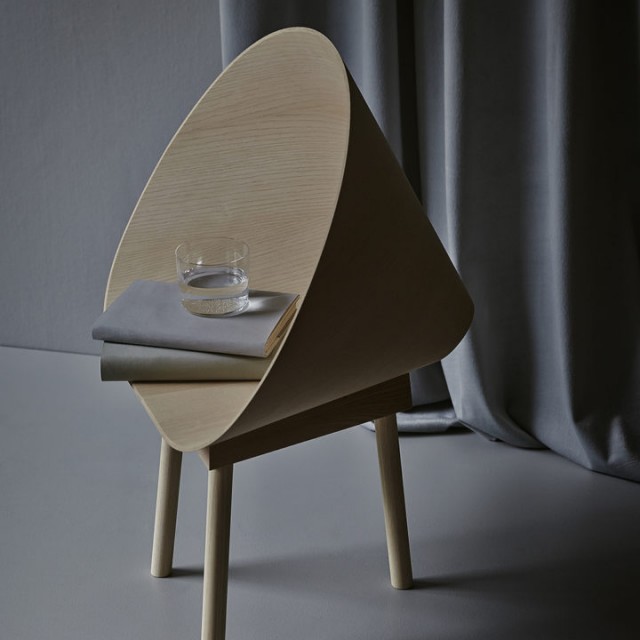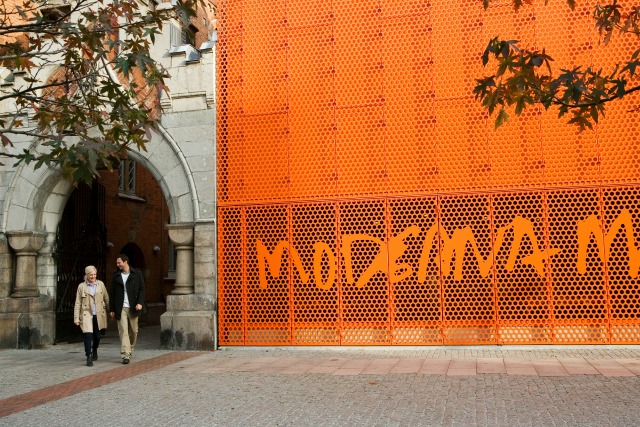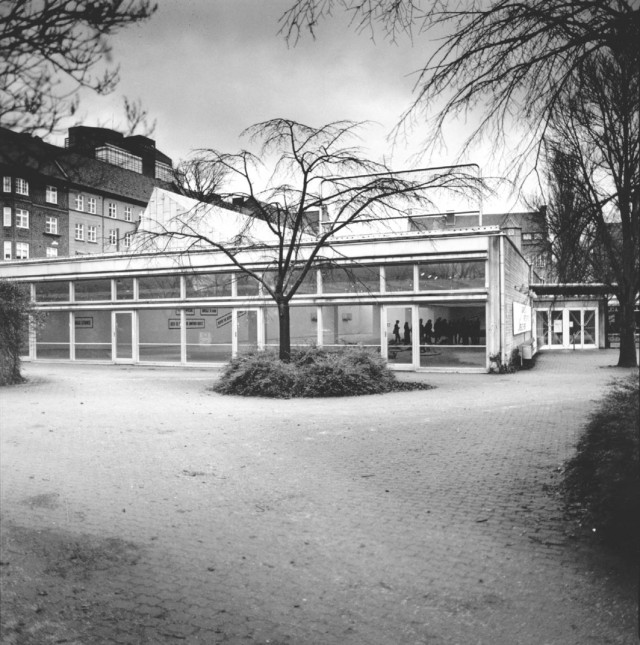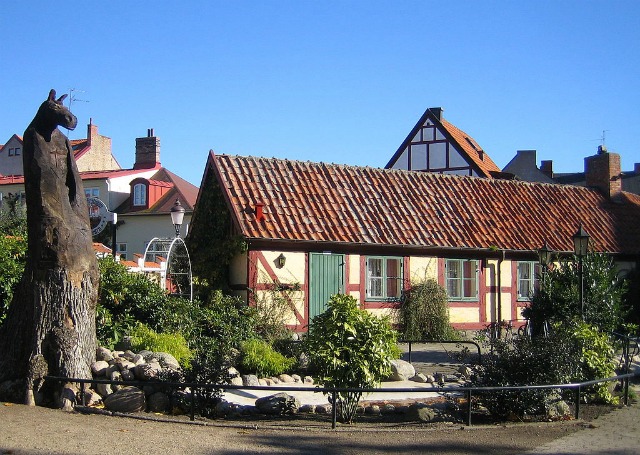Pinned to the southern tip of Sweden is Skåne, a continental county knitted together by vast flat fields, cream sandy beaches, and lush deciduous forests.
With a combined population of just 1.2 million, even its biggest cities — Malmö, Helsingborg and Lund — are far from bustling. Yet Skåne is a hotbed of creativity with design gems and activities around practically every corner.
“I think it’s the underdog perspective that makes Skåne such a creative place,” says Skåne-dwelling industrial designer Terese Alstin, co-founder of Hövding helmets and head of design development at Malmö’s Form/Design Center.
 The 'Hello Little Fella' table by Lovusa Hansson from an exhibition at Form/Design Center in Malmö. Photo: Fanny Hansson
The 'Hello Little Fella' table by Lovusa Hansson from an exhibition at Form/Design Center in Malmö. Photo: Fanny Hansson
And if there’s anyone who knows about pushing boundaries, it’s Terese. In 2005, along with Anna Haupt, she invented the world’s first airbag bicycle helmet. It’s also no coincidence that it was invented in Malmö, Sweden’s best city for cyclists. The stylish and safe accessory won the world’s most prestigious design award, The INDEX: Award, in 2011.
“We showcase design and architecture to the public, showing how design can solve a lot of problems and improve life for people in different ways,” explains Terese. “And we host many different exhibitions as well as talks and lectures, seminars and workshops.”
Plan ahead for your visit and book a spot in one of the centre’s regular seminars – you can learn a new craft, and get to know some fellow creatives. Everyone is more than ready to share and discuss ideas, something Terese says the region is becoming well-known for: “There’s a really nice sense of community in Skåne, which is great in an industry that’s so competitive.”
 Malmö Moderna Museet. Photo: Miriam Preis/Imagebank Sweden
Malmö Moderna Museet. Photo: Miriam Preis/Imagebank Sweden
While you’re in the neighbourhood, she also recommends another Malmö must-see, just 700m from the Form/Design Center – the Moderna Museet. It’s a little sister of Stockholm’s Moderna Museet, one of Europe’s foremost museums of modern and contemporary art.
Housed in one of Sweden’s most remarkable exhibition halls, an early-20th century electricity plant formerly home to the Rooseum Center for Contemporary Art, the building has been recently redeveloped by award-winning architects Tham & Videgård.
The new annex, with its perforated orange-red sheet metal facade, is connected to the brick architecture of the historic building – it’s a beautiful way of bridging the old and the new (and very Instagrammable!). The exhibitions rotate often, showcasing a selection of modern art’s most famous artists, and a varied learning programme is offered throughout the year.
If you love modern art then Malmö’s Konsthall is one of Europe’s biggest exhibition halls and an absolute essential for your visit. Designed by architect Klas Anshelm, the light, open space – typical of Scandinavian design – displays some of the world’s finest artwork. Past exhibitions include sculptor Lars Englund, photographer Åke Hedström, and Spanish romantic painter Francisco Goya.
 Photo: Malmö Konsthall/konsthall.malmo.se/
Photo: Malmö Konsthall/konsthall.malmo.se/
Malmö is just one of the many places in Skåne where you can get your creative fix. If you’re staying in the city but you’re willing to travel a little outside, there are design treasures to be discovered all over the county.
Hop on the train at Centralstation in Malmö and you can be in Lund in just 10 minutes, where you’ll find Skissernas, a fascinating museum about the artistic process.
From pencil drawings to plaster sculptures, explore the inner workings of the creative mind with pieces from international artists including Henri Matisse, Henry Moore, and Sonia Delaunay. The museum is also home to one of Europe’s largest collections of sketches by Mexican painter and muralist Diego Rivera.
While you’re in Lund don’t miss Kulturen, an open air and indoor museum filling two blocks in the city centre. The historic buildings are set within scenic gardens, and you can explore 20 exhibitions covering everything from folk art and modern design to textiles and glass art. You can easily spend several hours wandering around, so grab your walking shoes and put on your creative hat.
On Skåne’s southeast coast is artist’s haven Ystad, a town that has attracted creatives for decades. It’s really easy to get to, you can hop on a train at Malmö and you’ll be there in under an hour, or if you have a car, it’s 50 minutes down the E65.
It has a quaint village feel, and there’s art to be found in every nook and cranny, with galleries, studios, and artists’ homes dotted around the town.
 Artwork in quaint Ystad. Photo: Jorchr/Creative Commons
Artwork in quaint Ystad. Photo: Jorchr/Creative Commons
You’ll also find Tjörnedala Konsthall, the shared space of East Skåne Artists’ Society (ÖSKG), a gallery that organises six to eight exhibitions a year and also arranges workshops and seminars for artists.
It’s open year round, and one of the essential stops on the ÖSKG’s annual Konstrundan, an art circuit that takes place over Easter around Ystad and the surrounding Österlen region. Nearly 100 members participated in 2017, so the biggest problem you’ll have is deciding which of the many galleries and studios to visit.
 Wanås Konst in Vanås. Photo: TS Eriksson/Creative Commons
Wanås Konst in Vanås. Photo: TS Eriksson/Creative Commons
If you want to get even further off the beaten path, Terese recommends travelling north of Malmö to the Wanås Konst Center in Vanås, a foundation that works to transform our view of society through innovative art, learning, and a focus on equality.
“You can see art and nature come together in an amazing way, and there’s an outdoor exhibition in the forest close to the castle,” she explains.
The scenic centre consists of an art gallery, medieval castle, organic farm, and sculpture park that’s open all year round. Its permanent collection features around 70 world-class artworks that have been created specifically for the centre by international artists including Yoko Ono, Ann Hamilton, Jenny Holzer, and Ann-Sofi Sidén.
With all this creativity on her doorstep, it’s no wonder Terese says proudly that “the design scene in Skåne is very special”. We’re inclined to agree, and with all this on offer have no doubt you will too.
Read also: The Stockholm design hot-spots you have to see
This article was produced by The Local Client Studio and sponsored by Visit Sweden.



 Please whitelist us to continue reading.
Please whitelist us to continue reading.